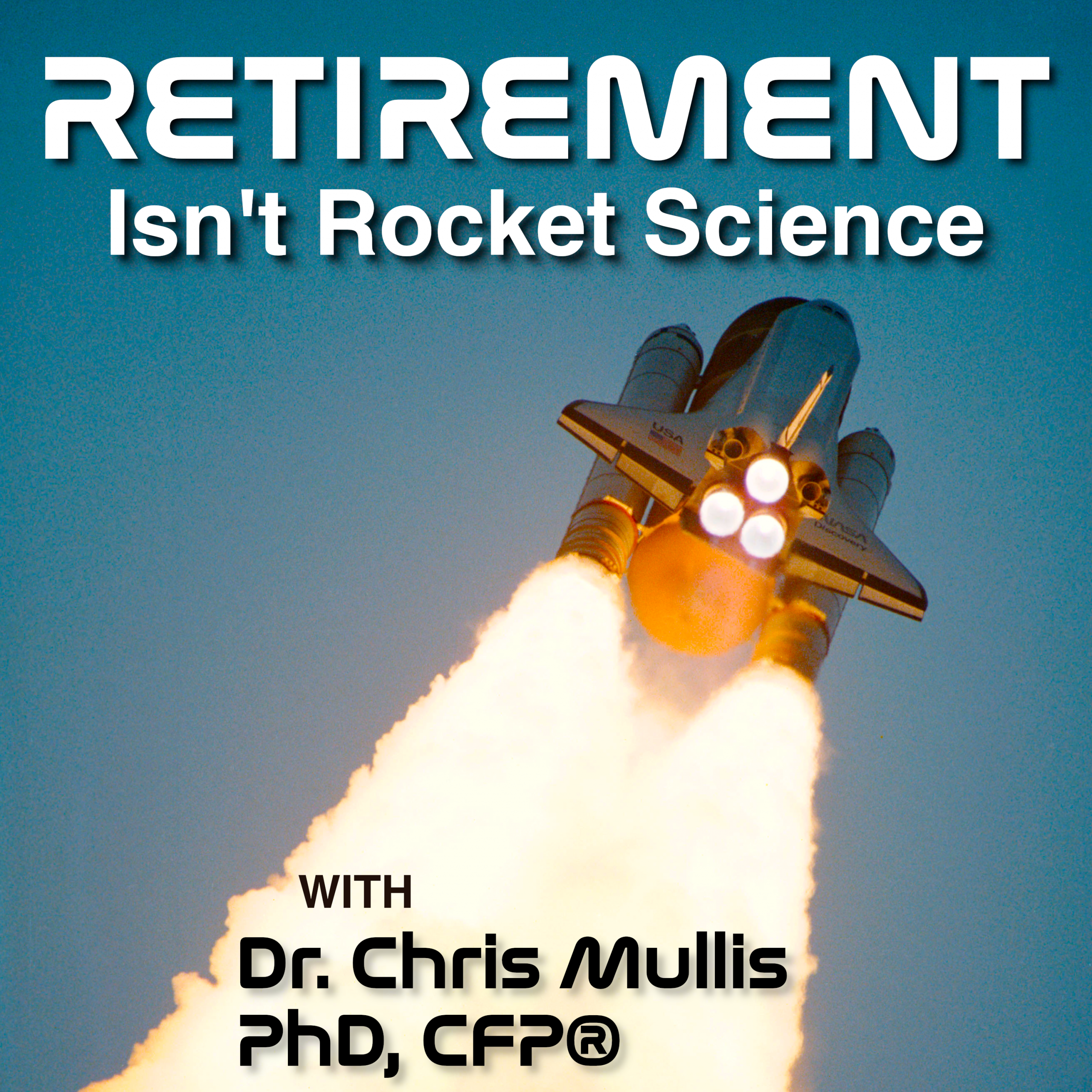The Unseen Four: Unexpected Risks That Could Derail Your Retirement

Don’t let unexpected risks derail your well-earned retirement! In this episode, Dr. Chris breaks down the four unique and often-overlooked risks — like sequence of returns and spiking expenses — that make spending money in retirement fundamentally different from saving it. You’ll learn the crucial strategies, from income planning to tax management, that will help you confidently navigate your financial orbit and ensure your nest egg lasts as long as you do.
Retirement Big Picture
We journey to the Bull’s Eye Galaxy, a colossal structure two-and-a-half times the size of the Milky Way. This spectacular sight holds the record for the most concentric rings of stars, a result of a rare, nearly perfect head-on galactic collision. The Bull’s Eye doesn’t just look amazing—its ring structure perfectly confirms a long-established theoretical model, making it a natural laboratory for studying galaxy evolution.


Sign Up for The Launch
The Launch is a weekly email from Dr. Chris and his team. It’s full of retirement tips, news, listener questions & more, straight from us to your inbox. Get smarter about retirement in just 5 minutes every week. Let’s go!
Episode Resources
- The Four Unique Risks in Decumulation
By Peter J. Neuwrirth
Episode Transcript
Introduction
Managing the four unique risks of retirement. Avoiding a lifetime penalty from Medicare and finding the bullseye galaxy. Are you ready?
Welcome back to Retirement Isn’t Rocket Science. I’m your host, Dr. Chris Mullis, Certified Financial Planner and former rocket scientist.
If you want to spend more money in retirement while paying less in taxes, you’re in the right place. And if you’re excited about the freedom and opportunity to finally live life on your own terms.
You’re in the right place. My mission is simple to cut through all the confusing jargon and empower you with the proven strategies and mindset you need to worry less and retire more.
In today’s show, we examine the four unique risks that retirees face. We answer your questions about Medicare and we take a close look at two worlds colliding with a beautiful bullseye galaxy. Now let’s dive in.
Retirement Briefing Room
Welcome to the Retirement Briefing Room. This is where we huddle up to take a close look at retirement related research and news articles, and think about how to integrate these into your plans to make your retirement even better.
We’re kicking off this segment by looking at a fantastic, insightful article titled “The Four Unique Risks and Decumulation.” This piece was written by Peter Neuwirth, an actuary, author, and thought leader in the retirement risk management space, and it was published in Advisor Perspectives the article’s main focus is to highlight the stark differences between the accumulation phase. Those are your saving years and the decumulation phase. You’re spending years of retirement while accumulation has been widely researched and has established strategies, Peter argues that safely spending down your assets is a fundamentally different and arguably harder problem in my retirement planning firm, we do everything for our clients, investments, tax, insurance, estate, and income Planning. By far, the most complex and most interesting is income planning. That means how to best blend all of your sources of income in retirement, maximizing your spending, maximizing your confidence, and ensuring you never run out of money.
Peter specifically identifies four risks that are either non-existent or minimal during your working life, but become critically important the moment you retire.
For our listeners, diligent savers with healthy nest eggs. Understanding and mitigating these four unique risks is crucial for a stress-free and successful retirement.
The first risk is sequence of returns. This is arguably the most famous risk of early retirement. It’s the one we talk about most often, but it bears repeating because it’s so critical. The sequence of return risk isn’t about the average return of your portfolio over 30 years. It’s about the order as this sequence in which those returns occur.
If you have to start taking withdrawals to live on in the first few years of retirement, and the market decides to take a major downturn. You are forced to sell shares when they’re at their lowest value. Of course, we call that selling low.
This drastically accelerates the depletion of your portfolio and can prematurely exhaust a nest egg that otherwise should have lasted.
There are two broad ways to deal with sequence of return risk. First through income planning, that is creating a protected cash flow source for your early retirement years. This could mean having a few years of living expenses set aside in cash or high quality bonds that aren’t tied to the stock market’s volatility.
That way, if the market drops, you can draw from that war chest and let your main investment portfolio recover without being forced to sell low. Second…we operate with a guardrail strategy that tells us when and how much to tap the brakes on spending. If the market pullback becomes extended.
The second key risk is longevity. The risk of living too long. Think about that. You are a nice diligent saver who’s generally healthy, which means you’re more likely to live a long life.
Peter’s article points out that longevity risk, the risk of outliving your money doesn’t stay static. It actually becomes exponentially more important as you get older and healthier. The math is simple. Every birthday you hit in good health increases the statistical chance that you’re gonna live even longer.
Here Peter is flexing his actuarial wisdom.
This is an essential piece to our financial modeling that we do for clients when we build a plan, we’re not just hoping our client lives to 85, we’re stress testing it to at least 95 and sometimes beyond, depending on their personal health history. And again, our guardrail strategy naturally tracks this longevity risk guiding us to be a little bit more prudent and cautious with our spending in the earlier phase of retirement when we still have.
Perhaps 20 or 30 years of life to fund, but releasing those stops or guardrails out as we grow older and we have less years ahead to have to pay for
The third unique risk of retirement is taxes. When you’re working your annual tax bill is generally predictable and manageable without too much effort, but in retirement, as Peter points out, you should view your annual tax expense.
As a moving variable and what he calls a source of tax expense risk. Now, why does Peter say this? It’s because how much you need to withdraw and where you withdraw those funds from, be it a taxable tax deferred or tax-free account drastically impacts your tax bill. Throw into fluctuating required minimum distributions, potential changes to tax law, and the timing of social security benefits.
And suddenly your annual tax expense could be all over the map unless you smartly incorporate tax planning in your overall retirement plan
This is where a huge amount of value is delivered by a tax focused retirement planning specialist. They will ensure you are drawing from the most advantageous accounts each year.
The article highlights an interesting idea treating a Roth IRA conversion as an insurance premium against future high tax rates By paying a controlled lower tax rate on a chunk of your money, now you insulate that money from whatever future tax changes Congress might enact. This proactive tax planning is a fundamental part of keeping your retirement lifestyle sustainable. Preventing the risk of an unusually large portfolio withdrawal due to a surprise large tax bill.
The fourth unique risk of retirement is spiking expenses. Peter argues that this is perhaps the most understudied and potentially catastrophic risk… spiking expenses in retirement. This is when a significant unexpected event, like an extended family crisis, the fallout from a natural disaster or a major uninsured health event, forces a sudden massive withdrawal from your portfolio.
As the article states, this is mathematically equivalent to making this sequence of return risk worse. As a large withdrawal at an inopportune time can completely derail an otherwise well-designed to plan.
The job of a retirement planning specialist like myself is to help you prepare for the known unknowns. While we can’t predict a family emergency, we can make sure you have insurance and estate plans in place for the most common and expensive scenarios. We focus on risk management here for instance, addressing the risk of long-term care needs with insurance or a self-insured buffer. Home equity is often a right sized solution to address this. And ensuring your insurance coverage is up to date to manage unexpected medical or legal costs,
The key is to have a liquid buffer asset, not just for market volatility, but for these spikes and risks. So the surprise expense doesn’t require us to sell off a chunk of your core long-term investments and or generate a massive tax bill while doing so.
The decumulation, or what I like to say, the utilization phase of life is a different animal than the accumulation phase. Let’s say that more plain English, right? Living off your hard earned and built nest egg is profoundly different than what it took to build it up.
It shifts from an investment problem to a cashflow and risk management problem. By understanding and planning for these four unique risks. Sequence of returns, longevity, tax, and spiking expenses. You can launch your retirement with confidence, ensuring you’re always ready for the unexpected.
We thank Author Peter New for this Thoughtful Retirement article. If you’re interested in learning more, there’s a link to the advisor perspective article in today’s show. Notes that you’ll find in our weekly newsletter. The launch. You can sign up for the launch at retirement isn’t rocket science.com.
Now let’s head over to mission Control to answer your financial and retirement questions.
Ask Mission Control
This week’s listener question regards Medicare Part D, which is prescription drug coverage
She writes , I’m turning 65 soon and getting ready to sign up for Medicare. Thankfully, I don’t take any prescriptions at this time, so I’d like to skip Medicare Part D and not have to pay those premiums. Is there anything wrong with my plan?
So here’s The problem. You might not need medications today, but likely sometime between now and say the next 20 or 30 years you’re going to need them. And when you go to sign up for Medicare part D. You’re going to get hit with a big penalty in the form of a much higher Part D premium for the rest of your life.
In case you’re wondering that penalty is a 1% increase in your premium for each month, you delayed in signing up. So if you skip out on Part D at age 65, but pick it up three years or 36 months later, your Part D premium will be marked up 36% for the rest of your life.
Not good. So here’s what you might consider. Sign up for the lowest premium Part D plan that’s offered in your area. Believe it or not, some of these can have a zero premium. That way you’ve checked the box of Medicare Part D and avoid a lifetime and not small financial penalty, but your prescription coverage cost is minimal, especially while your medications are low.
If you’ve got a retirement question that you’d like us to answer on the show, head over to retirement isn’t rocket science and click ask a question. Or even better, you can skip to the front of the line by calling Mission Control at 704-234-6550 and record an audio question. Again, that’s 704-234-6550.
Now let’s broaden our perspective and explore a beautiful corner of our universe.
Retirement Big Picture
Welcome to the Retirement Big Picture part of our show. This is where we look up and look out to expand our appreciation and understanding of our amazing universe. Before I was a certified financial planner and retirement planning specialist, I spent almost two decades studying the cosmos as an observational astronomer .
So this subject is near and dear to my heart and mind. Today’s big picture is the bullseye, a Collisional ring Galaxy, formally known as LEDA1313424. Astronomers are very romantic when it comes to naming galaxies.
Now here are three cool facts about the Bull’s Eye galaxy. First, the bullseye holds the record for the most rings discovered in a single galaxy with a total of nine concentric rings of stars. Other known collisional ring galaxies typically only have one to three rings making this galaxy an incredible, rare and spectacular sight.
The sheer number of rings is why astronomers aptly named it the Bull’s Eye. Fact number two, the bullseye striking appearance is the result of a rare, nearly perfect head-on collision that occurred just 50 million years ago.
A much smaller blue dwarf galaxy shot straight through the middle of LEDA1313424. Like a cosmic dart. This impact created massive shock waves in the gas and dust causing them to ripple outward and trigger intense bursts of star formation that we see today as bright concentric rings.
The dwarf galaxy is still visible today, located about 130 light years away from the Bull’s Eye itself.
In fact, number three, it’s gigantic and confirms a longstanding theory. The Bull’s Eye galaxy is a colossal structure spanning approximately 250 light years in diameter, which is about two and a half times the size of our own Milky Way Galaxy furthermore. The way the rings are spaced out, clustered tight near the center and becoming more widely separated further out, almost perfectly confirms a long-established theoretical model for how these ring structures should form after a head-on galactic collision. This makes the bullseye a crucial natural laboratory for studying galaxy evolution and even the distribution of dark matter.
Conclusion
You’ll find a stunning image of the Bull’s Eye galaxy. Today’s show notes and today’s featured retirement article in our weekly newsletter. The launch. Sign up for the launch at retirement isn’t rocket science.com. That’s all we have for you this week. Thank you so much for joining me.
Until next time, I’m Dr. Chris reminding you that your retirement doesn’t have to be rocket science, but it can be as exciting as a moonshot. So aim high and, of course, plan well.
Credits
We thank the National Aeronautics and Space Administration for providing the radio communication between the space shuttle astronauts and the flight controllers.
Disclaimer
This show is for informational and entertainment purposes only. It is not specific tax, legal or investment advice.
Before considering acting on anything you hear in this show, first consult your own tax, legal or financial advisor.


